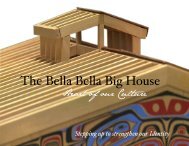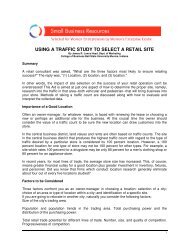Cascade NTFP Regional Profile.pdf - First Nations in British ...
Cascade NTFP Regional Profile.pdf - First Nations in British ...
Cascade NTFP Regional Profile.pdf - First Nations in British ...
You also want an ePaper? Increase the reach of your titles
YUMPU automatically turns print PDFs into web optimized ePapers that Google loves.
<strong>Cascade</strong>s <strong>NTFP</strong> <strong>Profile</strong><br />
<strong>Regional</strong> Forest Land Use<br />
Similar to other forested areas of the Prov<strong>in</strong>ce, the primary management objectives of the<br />
forest landbase are centred on timber harvest<strong>in</strong>g.<br />
Review of the Lillooet LRMP Perta<strong>in</strong><strong>in</strong>g to NTFRs<br />
Found with<strong>in</strong> the Lillooet LRMP (2004) is direction concern<strong>in</strong>g the management of<br />
NTFRs. Objective number 4 <strong>in</strong> section 2.1, reads: “Encourage <strong>in</strong>novative silvicultural<br />
and harvest<strong>in</strong>g regimes to achieve management objectives for non-timber resources”.<br />
There are two areas of management direction for this objective:<br />
4.1 Encourage timber harvest<strong>in</strong>g where it would benefit wildlife (refer to details<br />
<strong>in</strong> wildlife, Species at Risk, and Forest Biodiversity and Grassland Ecosystems)<br />
4.2 Where management for non-timber resources has the potential to make<br />
harvest<strong>in</strong>g timber harvest land base (THLB) uneconomical, consider <strong>in</strong>novative<br />
regimes to resolve the conflicts<br />
The measures of success/target are: Innovative silvicultural and harvest<strong>in</strong>g regimes used<br />
to achieve management objectives for non-timber resources. The <strong>in</strong>tent is:<br />
The entire THLB will not require <strong>in</strong>novative silvicultural or harvest<strong>in</strong>g systems to<br />
achieve management objectives for nontimber resources. A significant proportion<br />
of the plan area is currently managed us<strong>in</strong>g <strong>in</strong>novative practices. These practices<br />
might <strong>in</strong>clude: adjusted cutblock, size or shape to reta<strong>in</strong> visual quality; modified<br />
clearcut systems, such as small patch clearcuts, feathered edges, green tree<br />
retention or deciduous tree retention; harvest and leave patterns; alternative<br />
harvest<strong>in</strong>g systems, such as highlead, helicopter, small mach<strong>in</strong>ery or horselogg<strong>in</strong>g;<br />
and alternative silvicultural systems, such as selection or shelterwood (p.<br />
8).<br />
Objective 10 reads: “M<strong>in</strong>imize impacts of resource management activities on botanical<br />
forest products”. Its management direction is: “10.1 Review the impacts of resource<br />
management activities on the use and collection of botanical forest products.” There are<br />
no measures of success listed.<br />
Section 3.3 Cultural and Historic Resources also conta<strong>in</strong>s language perta<strong>in</strong><strong>in</strong>g to NTFRs<br />
<strong>in</strong> relation to <strong>First</strong> <strong>Nations</strong>. Objective 3 reads: “3. Manage <strong>First</strong> <strong>Nations</strong> cultural symbols<br />
e.g., traditionally used plants, animals, and natural features), so that their value is<br />
acknowledged <strong>in</strong> plann<strong>in</strong>g for other resource activities”. There is no other text to<br />
support this objective, likely because the Prov<strong>in</strong>ce rema<strong>in</strong>s <strong>in</strong>volved <strong>in</strong> consultations with<br />
the <strong>First</strong> <strong>Nations</strong> on this document.<br />
Section 3.5, Access and Transportation does not address issues concern<strong>in</strong>g the access of<br />
NTFRs. Section 3.5.2 does mention the need to work with <strong>First</strong> <strong>Nations</strong> on the<br />
transportation <strong>in</strong>frastructure to meet the needs of their activities.<br />
Section 4.3.3 grizzly bear <strong>in</strong>cludes discussion about NTFRs such as the huckleberry and<br />
its management. Referenced with<strong>in</strong> this discussion is the need to prevent damage to<br />
huckleberries though timber harvest<strong>in</strong>g.




